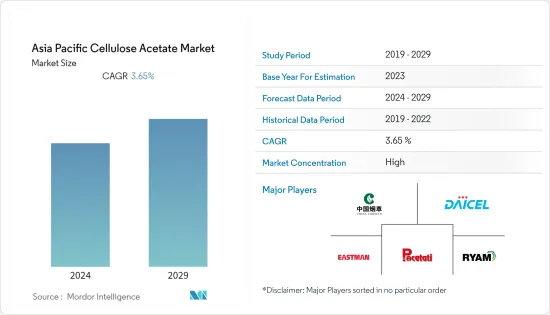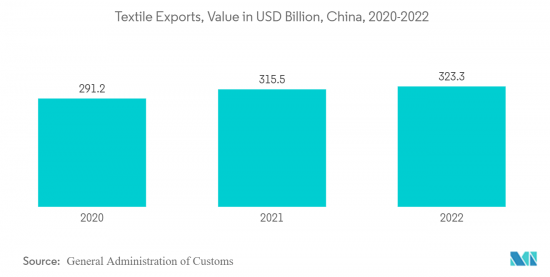PUBLISHER: Mordor Intelligence | PRODUCT CODE: 1408593

PUBLISHER: Mordor Intelligence | PRODUCT CODE: 1408593
Asia Pacific Cellulose Acetate - Market Share Analysis, Industry Trends & Statistics, Growth Forecasts 2024 - 2029

The Asia-Pacific cellulose acetate market is estimated to reach 393.09 kilotons by the end of this year and is projected to reach 470.26 kilotons in the next five years, registering a CAGR of 3.65% during the forecast period.
The market was negatively impacted by COVID-19 due to nationwide lockdowns in several countries in the region, which led to supply chain disruptions. Production declined as several responsible factories were shut down during the pandemic. However, the market started recovering and returning to pre-COVID levels in 2021.
Key Highlights
- Growing demand for cellulose acetate from the textile industry and high tobacco usage in some countries are the major driving factors that stimulate market demand.
- However, the market's growth is hindered by stringent government regulations on tobacco usage along with the declining demand for cellulose acetate in photographic films.
- Increasing the use of cellulose acetate for water treatment due to the low cost of these membranes, biodegradability, and non-toxicity are likely to create opportunities in the Asia-Pacific region over the coming years.
- China is expected to dominate the Asia-Pacifc cellulose acetate market as it is the largest manufacturer of cigarettes and the largest exporter of textiles in the world.
Asia Pacific Cellulose Acetate Market Trends
Growing Demand from Textile Industry
- Cellulose acetate fiber is used to make textile fabrics for clothing. In the textile industry, these fabrics can be used to make knitwear, wedding attires, formal shirts, suits, coats, sweaters, sportswear, hats, blouses, and undergarments. They can also be used in umbrellas, drapes, curtains, carpets, and other home decor such as soft and luxurious fabrics.
- China is the leading global manufacturer and exporter of textile products. In 2022, China experienced a 2.53% increase in its exports of textiles and apparel, when compared to the previous year, reaching a total value of USD 323.3 billion.
- Further, by 2025, it is projected by the China National Textile and Apparel Council (CNTAC), the regulatory authority overseeing China's textile and apparel sector, that the annual retail sales of clothing in China could surpass USD 415 billion.
- India is the second-largest textile manufacturer after China. Active government support and investments in the form of PLI schemes have prominently aided the country in the growth of the textile sector.
- The Indian textile industry is also attractive due to its skilled workforce and lower production costs. Furthermore, raw materials such as cotton, wool, silk, and jute are abundant.
- All these factors have been influencing the growth of textile sector and thereby the demand for cellulose acetate.

China to Dominate Cellulose Acetate Market
- Cigarettes are made of four major components: filter tobacco, additives, and cigarette wrappers. Cigarette filters are designed to absorb the vapors and accumulate the particulate smoke components. Filters also prevent tobacco from entering a smoker's mouth and provide a mouthpiece that will not collapse as the cigarette is smoked.
- China is the world's largest producer and consumer of tobacco. China has more than 350 million smokers. China's production of cigarettes has witnessed a consistent increase in recent years indicating positive demand sentiments.
- As per the data from the National Bureau of Statistics, in 2022, China produced 2.43 trillion units of cigarettes showcasing a marginal rise of 1% compared to the previous year.
- Cellulose acetate is also consumed in a wide range of plastic applications such as films, packaging, and others. There are more than 12,000 state-owned, local government-owned, private, and foreign-funded producers of plastics and related products in China. Continuous investments in the plastic industry in China are expected to keep the demand for cellulose acetate substantial from the industry in the coming years.
- In 2022, BASF SE inaugurated its first plant of 60 kilotons of engineering plastic compounds per year for customers in China. The plant aims to cater to the demand for engineered plastics from the automotive and construction industry.
- All these factors are expected to keep China ahead of other Asian countries in the cellulose acetate market in the coming years.
Asia Pacific Cellulose Acetate Industry Overview
The Asia-Pacific cellulose acetate market is consolidated by nature. Some of the major players in the market (in no particular order) include Sichuan Push Cellulose Acetate Co., Ltd., Daicel Corporation, RYAM, Eastman Chemical Company, and China National Tobacco Corporation, among others.
Additional Benefits:
- The market estimate (ME) sheet in Excel format
- 3 months of analyst support
TABLE OF CONTENTS
1 INTRODUCTION
- 1.1 Study Deliverables
- 1.2 Study Assumptions
- 1.3 Scope of the Study
2 RESEARCH METHODOLOGY
3 EXECUTIVE SUMMARY
4 MARKET DYNAMICS
- 4.1 Market Drivers
- 4.1.1 Growing Demand from Textiles Industry
- 4.1.2 Growing Consumption of Tobacco Products
- 4.1.3 Other Drivers
- 4.2 Market Restraints
- 4.2.1 Stringent Government Regulations Regarding Tobacco Usage
- 4.2.2 Declining Demand for Photographic Films
- 4.3 Industry Value Chain Analysis
- 4.4 Porter's Five Forces Analysis
- 4.4.1 Threat of New Entrants
- 4.4.2 Bargaining Power of Buyers
- 4.4.3 Bargaining Power of Suppliers
- 4.4.4 Threat of Substitute Products
- 4.4.5 Degree of Competition
5 MARKET SEGMENTATION (Market Size in Volume)
- 5.1 Type
- 5.1.1 Fiber
- 5.1.2 Plastics
- 5.2 Application
- 5.2.1 Cigarette Filters
- 5.2.2 Photographic Films
- 5.2.3 Plastics
- 5.2.4 Textiles
- 5.2.5 Other Applications (Cosmetics, Healthcare, etc.)
- 5.3 Geography
- 5.3.1 China
- 5.3.2 India
- 5.3.3 Japan
- 5.3.4 South Korea
- 5.3.5 ASEAN Countries
- 5.3.6 Rest of Asia-Pacific
6 COMPETITIVE LANDSCAPE
- 6.1 Merger & Acquisitions, Joint Ventures, Collaborations, and Agreements
- 6.2 Market Share (%)**/Ranking Analysis
- 6.3 Strategies Adopted by Leading Players
- 6.4 Company Profiles
- 6.4.1 Borregaard AS
- 6.4.2 Celanese Corporation
- 6.4.3 Central Drug House
- 6.4.4 China National Tobacco Corporation
- 6.4.5 Daicel Corporation
- 6.4.6 Eastman Chemical Company
- 6.4.7 Mitsubishi Chemical Corporation
- 6.4.8 RYAM
- 6.4.9 Sichuan Push Cellulose Acetate Co., Ltd.
7 MARKET OPPORTUNITIES AND FUTURE TRENDS
- 7.1 Increasing Use of Cellulose Acetate for Water Treatment
- 7.2 Other Opportunities




